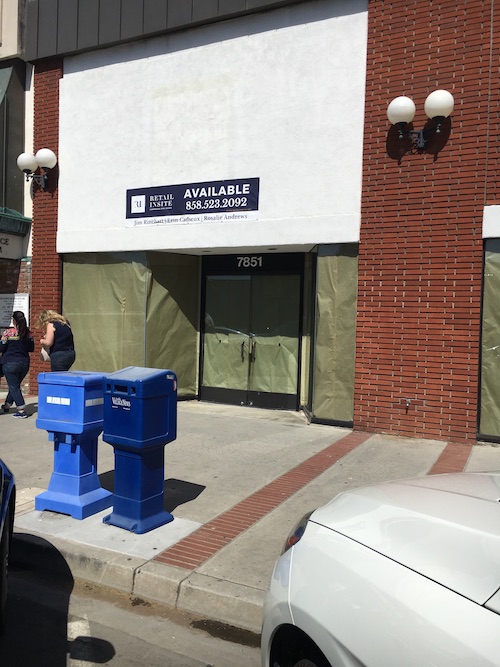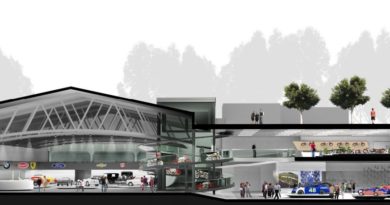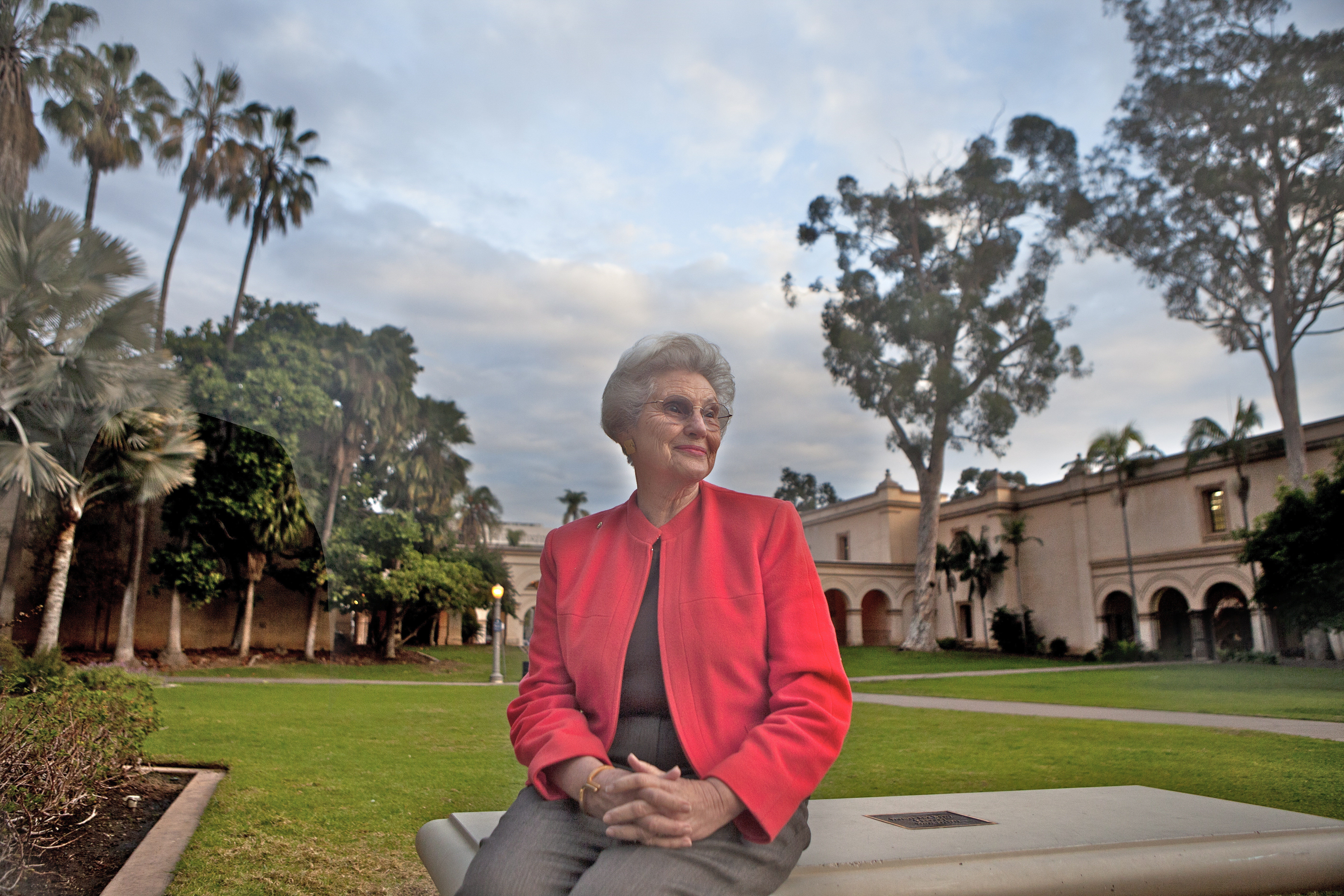La Jolla — The Vanishing Village
Today, when you walk up and down the two main streets in La Jolla, you will see a lot of empty storefronts and, frankly, it no longer holds that pristine look.
Empty Storefronts, Horrible Traffic,
Parking Nightmares Blemish
La Jolla’s Once-Pristine Image
By Randi Crawford
“Think globally, act locally,” coined by David Brower in 1970, is often associated with the environmental movement. But I believe that if town centers are to survive, it may be the only way to fight against the seismic shift taking place all over the country with respect to how people shop and spend their time.
I moved to California in 1998. My husband and I looked at homes in La Jolla, a place we had never been before, and couldn’t get over the sheer beauty. It felt like we were in Europe with the homes on the hills, overlooking the bluffs and the ocean below. It was magnificent. And in the heart of this beautiful setting was the downtown with Prospect and Girard streets that boasted lots of people shopping, eating and simply strolling on a beautiful, sunny, California day.
Today, almost 20 years later, La Jolla, with approximately 48,000 residents is still surrounded by its beauty, with exquisite homes and so much to offer, including: UCSD Scripps Institute of Oceanography, museums, the La Jolla Playhouse, fine dining and beautiful hotels. Tourists can watch the seals and sea lions, snorkel, kayak, hit up the Birch Aquarium, play golf at Torrey Pines overlooking the ocean, eat, sip specialty coffee and shop.
Needless to say, La Jolla has it all. But does it?
Today, when you walk up and down the two main streets in La Jolla, you will see a lot of empty storefronts and, frankly, it no longer holds that pristine look.
I spoke with several people who have lived in La Jolla for years (store owners, Realtors, restaurateurs), and have watched the decline. They have seen retail stores come and go. When I questioned people, I got a lot of great feedback, but there are some things that everyone universally agrees on, and they are obvious:
- Getting in and out of La Jolla is very challenging because there is only one road. 2. Traffic is horrible.
- Parking is a nightmare.
I had some people tell me that La Jolla consists of these three things: restaurants, juice bars and gyms. There are lots of trendy gyms, regular gyms, yoga studios, Pilates studios, and one-on-one training facilities. One retailer told me about a new gym that was started by a few “hot Australian men with hot accents and even hotter bodies.” Apparently, that’s the place to be right now. And juice bars are popping up on every corner. Each one, more popular than the next.

While population demographics contribute to the success or failure of a downtown including age, education, income, housing ownership, home pricing and the town’s employment base, what I’m learning is that the majority of shopping in La Jolla is from tourists, and they aren’t shopping. La Jolla definitely has the demographics, but the locals don’t shop in town because there’s not much there and it’s inconvenient.
Scott Patrick, owner of Village Gifts and Engraving, moved his business from La Jolla to Solana Beach. He believes that several factors are contributing to the problem. “Online shopping has changed behavior. Now people can push a button and have something delivered to their door in two days,” he said. While his business in particular consisted of locals, he said that it’s hard to grow a business when people don’t drive in and can’t find parking. He also said that the rents are astronomical, especially on Prospect, and overall La Jolla is getting stale.
“La Jolla really doesn’t have a nightlife to speak of, nobody shops except for tourists during the summer, and the landlords drive the tenants out with the high rents,” said Marc Lipschitz, a Realtor who has been in La Jolla his whole life.
Sheryll Jackman opened her luxurious Seaside Homes, selling high-end home furnishings, in 2009, on Herschel Street immediately behind Brooks Brothers. She said her initial lease was attractive but that the escalation clauses and falling sales forced her to close the business. She closed Seaside Homes in 2014.
“When combined with our overhead, including the escalating costs of employees, it was impossible to cover the total costs by the gross receipts being generated due to the changes in the distribution channels,” said Jackman. “These changes in distribution channels and the way people were sourcing home furnishings, i.e., the Internet, imports from Asia, shipping concessions to individuals not available to businesses, the public’s expectations of deep discounts leaving retail vendors very little in the way of margins necessary to generate any kind of profits.”
Jackman also said that local custom fabrication of furnishings, especially upholstery “all led to the realization that we could no longer sustain the high-end services and products that had been our trademark.”
Jackman said businesses in La Jolla are “at the mercy of the city of San Diego” and “its much larger business taxes, special promo taxes, and a myriad of other taxes that businesses have to navigate and pay for just to do business in La Jolla to help carry the rest of the city.”
She said she believes another impediment which businesses in La Jolla have to cross is the lack of major tourist hotels in the village. “With convention hotels located miles away, it is most likely that their occupants would not visit the La Jolla Village.”
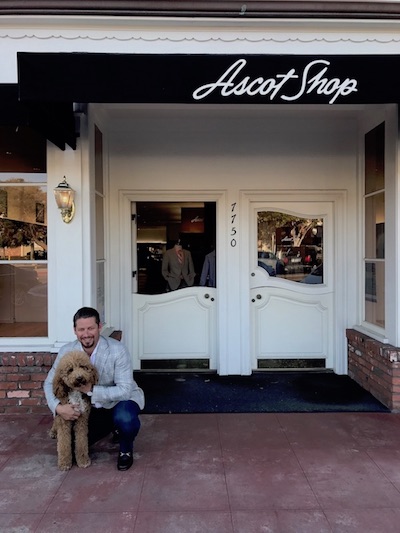
The Ascot Shop does a tremendous amount of work to bring people in the door, and keep them there. They host events every other weekend, they have trunk shows, and they stay progressive to keep up with customer needs.
Andy White, Ascot Shop owner, has personally seen several “big corporate retail chains” come and go within a three- to six-month time period. “The rents are high and there is virtually no foot traffic. There are a lot of tourists, but they just aren’t doing that type of shopping,” said White. He said that someone will come in from out of town, talk with him for 20 minutes, walk around the store admiring everything, and then leave.
White said his store is like a “museum” to travelers. When asked why he no longer carried the brand Vineyard Vines, he said it’s because no matter how much inventory he carries, if he doesn’t have exactly what a customer wants at that exact moment, they will go home and order it online. Even if White offers to order it and have it shipped directly to their house, they prefer to order it online. The Ascot Shop La Jolla is a family run business and they aren’t going anywhere. They may watch the big guys come and go, (Like Saks Fifth Avenue which tried not once, but twice in La Jolla), but this family is determined to keep that something special going.
Not so for another retailer. After 62 years, the Burns Pharmacy closed in 2014, bringing to an end a storied history in La Jolla. Burns was one of La Jolla’s oldest independently owned retail stores when it shut it doors in April, 2014.
Wayne Woods, a co-owner, said the financial viability of an independent drugstore on Girard Avenue was a driving force in their decision.
At the time of the closing, Woods told the La Jolla Light that “in recent years insurance companies has narrowed profits margins such that the pharmacy is no longer a profitable business.” He added that mail order pharmacies had also taken its toll on Burns.
Warwick’s is the country’s oldest family owned and operated bookstore located in the heart of La Jolla, but how do they stay in business with Amazon taking over the world? They sell books as well as specialty gifts, stationary and colorful office supplies. I met with Nancy Warwick and Julie Slavinsky, director of events and community relations, and they had a lot to say. I specifically asked them about their customer base, because it reaches far and wide, and Warwick’s does a lot to keep their customers happy. If you just go to their events calendar, it may look busier than your own. They have weekly author readings, a blog on their website, coffee every other Tuesday with their customers to discuss what’s new and worth reading, and an entire kid’s corner.
Warwick’s main attraction is the authors they bring into the store for book signings.
Despite the empty storefronts on Girard and Prospect, Warwick and Slavinsky remain positive about La Jolla. There are a lot of wonderful dining establishments for lunch and dinner that boast a thriving business. In fact, during lunchtime, Warwick always feels good to see so many people out and about because it makes La Jolla feel like it’s alive.
They agreed that it could use maintenance and upkeep, which is why they are happy with the MAD (Maintenance Assessment District) funds, which will be coming this year to start to make La Jolla look beautiful again. The community will be getting $502,000 annually to enhance the community including the landscape, street and sidewalk cleaning, litter and graffiti abatement, upgraded trash cans, benches, public art and tree canopies. This should help attract more independent store owners to consider La Jolla to open up for business.
They both felt that independent shops would do well, but they really like the idea of a “food hall/marketplace.” Their vision includes a fine cheese shop, a chocolatier, a butcher with organic grass-fed meats, a bakery, an olive vendor, a wine shop and specialty foods. Something like that would offer the locals and tourists a place to come together and have the experience they are looking for, while reinvigorating the village.
Amazon has clearly impacted their business. Their customer base comes in regularly, but their book sales are off. After our conversation, I realize that shopping with Amazon isn’t just a threat to retailers, it’s a threat to all of us, and we don’t even realize that we are the ones creating it. Almost nothing compares to the convenience of Amazon. In fact, nothing even comes close. But what we aren’t focusing on is the collateral damage that online shopping is creating within our own communities.
A study by Civic Economics analyzed Amazon and empty storefronts and concluded that the reality of the limited demand for retail space will ultimately affect every business district and shopping center in America. In 2015, Amazon sold $55.6 billion worth of retail goods nationwide, while avoiding $704 million in sales taxes. These sales are the equivalent of 39,000 retail storefronts or 133 million square feet of commercial space, which might have paid $528 milion in property taxes. That’s a total of more than $1.2 billion in revenue that is lost to state and local governments.
A woman who specializes in analyzing e-commerce said La Jolla isn’t an anomaly, but rather the norm. People are shopping online, period. But while you see the physical stores, and plenty of people walking around, do you actually see people shopping?
In order to survive, La Jolla must evolve to meet consumer demands. It needs to figure out its strengths because it can’t compete on price and convenience with online shopping.
There are some places that will survive and thrive in this new marketing world: specialty shops that give customers an experience, food, coffee and juice bars, and places where people need to physically go for waxing, eyelash extensions, jewelry repair, fitness programs and such.
____________________________
The Village of La Jolla Will Rise and Shine Again
By Delle Willett
The Village of La Jolla, “The Jewel by the Sea,” has lost some of its luster. Dirty sidewalks, potholed streets, overflowing trash cans and litter don’t go unnoticed by affluent visitors and business men and women who come from all over the world to look at investment properties with Mike Slattery of Cushman Wakefield, an industry-wide market expert, specializing in La Jolla since the mid-80s.
“It’s the first thing they notice when they come here. La Jolla has not been given the attention that they think it deserves. They are confused by this,” said Slattery.The problem is, in a nutshell, that La Jolla is an incorporated village of the city of San Diego and has not received the funds needed to improve and beautify itself. And La Jolla is unable to implement any projects in the public right-of-way (sidewalks, streets, medians) due to city liability regulations.
But that’s about to change.
The La Jolla Community Foundation supported an effort to establish a Maintenance Assessment District (MAD) for the Village of La Jolla, which was approved by those within the district by mail ballot and ratified Nov. 15, 2016, by the San Diego City Council.
“La Jolla will join 63 other MADs in San Diego; it’s a time-tested solution for raising additional money for the communities,” explained Nancy Warwick, owner of Warwick’s Bookstore and a member of the steering committee.
Starting in December 2017, commercial, recreational, nonprofits, multi-family and single-family residents will be assessed based on what each property owner would realize from services provided by the MAD. Residential owners will pay about 16 percent of the total collected and commercial properties will pay 84 percent of the total assessments.
The district has 1,347 properties with 1,158 owners. The city owns six parcels and must contribute $37,500 annually. The MAD annual budget is an estimated $502,000. Its boundaries are Coast Boulevard, La Jolla Boulevard, Pearl Street, Girard Avenue and Torrey Pines Road.
The funds raised will be applied to ongoing efforts to enhance the community, including landscape maintenance, street and sidewalk cleaning, litter and graffiti abatement, upgraded trash cans, additional trash collection, benches, enhanced signage, traffic-calming, public art, and tree canopies. This increased maintenance will begin in 2018.
Some maintenance of public parks within the district will be included in the MAD. Enhance La Jolla will work with city Parks and Recreation Department to determine what services should be provided in these areas.
The MAD will be administered by Enhance La Jolla, a nonprofit formed by the La Jolla Community Foundation, with a board of directors consisting of property owners and community stakeholders within the district. Enhance La Jolla will be responsible for preparing the annual draft budget, retaining contractors, and overseeing and administering the maintenance services.
It will have the ability to see projects through from fundraising to completion. The city of San Diego will oversee Enhance La Jolla’s administration of the MAD to ensure compliance with local and state statutes.
Warwick believes that there are many residents who will donate money to beautification projects, now that the MAD is in place. “I expect Enhance La Jolla, which will manage both the MAD assessments and spearhead capital campaign projects, will be very successful because the residents truly treasure the Village,” she said.
A proposed project through the MAD is “The Belvedere Promenade,” which will implement the 2004 La Jolla Community Plan of a pleasurable shopping and outdoor-dining pedestrian promenade on Prospect Street. Designed by architects Alcorn & Benton, The Belvedere plan relocates parking spaces and modifies the roadway for efficient and pedestrian-friendly vehicular travel. The new public Belvedere vista point will overlook Ellen Browning Scripps Park and the Pacific Ocean beyond—a destination for tourists and residents alike.
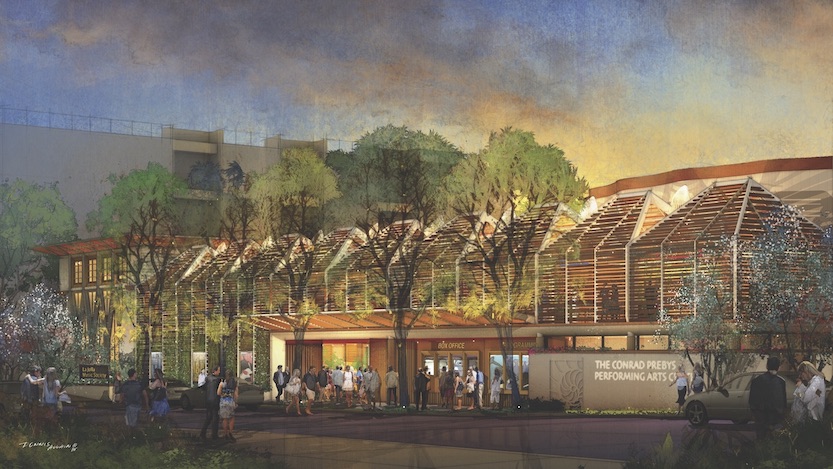
MAD compliments La Jolla’s Business Improvement District (BID); while the MAD focuses on physical projects and ongoing maintenance, the BID focuses on business development and retention.
The BID was established about 30 years ago and is managed by the La Jolla Village Merchants Association, an all-volunteer association whose mission is to enhance village merchants’ opportunities to do business. Sheila Fortune is the association’s executive director.
In the BID, business owners are assessed annually to fund activities and improvements to promote the business district. A BID is a tool for strengthening small business communities, creating new jobs and attracting new businesses through marketing and promotional events. BID boundaries are Torrey Pines Road, Prospect Avenue, the heart of the Village down to Coast Walk, La Jolla Boulevard and Pearl Street.
“What’s happening now is that there are a lot of foreign investors coming in and buying up the properties for investment and they don’t have an emotional connection to the Village or the property,” said Fortune. “So the all-voluntary association board is trying to reach out to them to help them develop a sense of place. To educate them why La Jolla is special. Why we need people to be engaged. Why they need to not just look at the bottom line. We watch the market and try to work with the new tenants, whoever that are, to care if they make it.”
The association is currently doing surveys to see what residents would like in the Village. “We are trying to find out what the residents want, what the tourists want, and proactively go after that type of business that fits their particular space.”
According to Warwick, La Jolla’s business community, with over 1,300 businesses, has managed to maintain a thriving residential base of support, despite being a popular and busy tourist fitness destination.
“In my opinion, we only need more children’s apparel stores and a gourmet market, now that Jonathan’s is gone. My dream is to have a gourmet food hall with a cheese shop, local butcher, chocolatier, bakery, and beer and wine purveyor. It would attract both residents and tourists, and it would add an exciting element to the community.”
Warwick is especially excited about a new arts district, developing on Fay Avenue. It includes the transformation of Jonathan’s market to The Lot, a state-of-the art movie theater, and The Conrad — The Conrad Prebys Performing Arts Center which will serve as a heart of cultural, community and arts education event activities in La Jolla.

